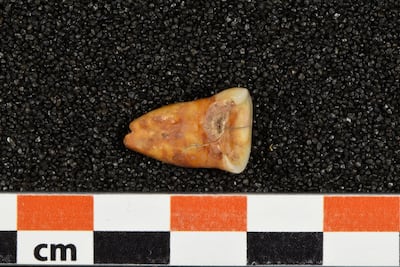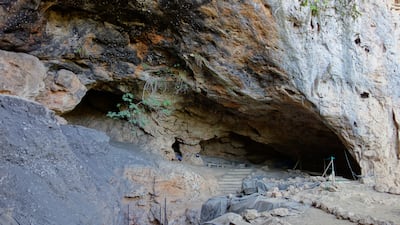The diet of ancient Moroccans included a “significant proportion” of plants, a new study has found, challenging the idea that people who lived before agriculture was developed primarily ate meat.
A team of researchers based in Germany, France and Morocco made the discovery after examining a human tooth found in the Taforalt cave, believed to be the oldest cemetery in North Africa.
Bodies of at least 34 Iberomaurusians, a prehistoric human population who lived in North Africa 11,000 to 25,000 years ago, during the North African Later Stone Age, lay untouched at the site near Oujda until they were discovered in 1908.
The researchers used existing techniques to examine collagen present in the tooth, as well as a new approach which analysed zinc isotopes in the dental enamel to determine the diet of Iberomaurusians.
The study showed that the diet of these hunter-gatherers included a “significant proportion” of plants belonging to Mediterranean species, predating the advent of agriculture by several millennia.
Botanical remains found at the site in north-eastern Morocco, including acorns, pine nuts and wild pulses, further bolsters the idea, researchers said.
They concluded that plant foods were also fed to infants and may have served as weaning products for the population.
They said the results challenge the idea that the diet of pre-agricultural human groups was heavily based on meat, while questioning the lack of agricultural development in North Africa at the beginning of the Holocene.
Lead study author Zineb Moubtahij from Geosciences Environnement Toulouse said: “Our findings not only provide insights into the dietary practices of pre-agricultural human groups but also highlight the complexity of human subsistence strategies in different regions.
“Understanding these patterns is crucial to unravelling the broader story of human evolution.”
Studies show that ancient Iberomaurusians seem to be related to Middle Easterners and other Africans, sharing around two thirds of their genetic ancestry with Natufians, who lived as hunter-gatherers 11,000 to 14,500 years ago in the Middle East.
The other third of their DNA came from ancient sub-Saharan Africans. North Africans today share a much larger proportion of European DNA.
Agriculture was developed about 10,000 years ago. Before then, all people got their food by hunting, gathering and fishing.
Evolutionary nutritionists, such as Loren Cordain, who wrote The Paleo Diet: Lose Weight and Get Healthy by Eating the Foods You Were Designed to Eat, said about three quarters of indigenous societies, such as tribes in South America, derive more than half of their calories from meat, suggesting their diet is similar to that of ancient hunter-gatherers.
Some experts believe eating meat was crucial to the development of ancestors’ larger brains.
The brain of a human at rest uses about 20 per cent of their total energy, whereas this figure is only 8 per cent for an ape, which led to the belief that, due to the emergence of our species, H. erectus, calorie-dense meat became people's primary energy source.
Pieces of Her
Stars: Toni Collette, Bella Heathcote, David Wenham, Omari Hardwick
Director: Minkie Spiro
Rating:2/5
UAE currency: the story behind the money in your pockets
UAE currency: the story behind the money in your pockets
Which honey takes your fancy?
Al Ghaf Honey
The Al Ghaf tree is a local desert tree which bears the harsh summers with drought and high temperatures. From the rich flowers, bees that pollinate this tree can produce delicious red colour honey in June and July each year
Sidr Honey
The Sidr tree is an evergreen tree with long and strong forked branches. The blossom from this tree is called Yabyab, which provides rich food for bees to produce honey in October and November. This honey is the most expensive, but tastiest
Samar Honey
The Samar tree trunk, leaves and blossom contains Barm which is the secret of healing. You can enjoy the best types of honey from this tree every year in May and June. It is an historical witness to the life of the Emirati nation which represents the harsh desert and mountain environments
COMPANY%20PROFILE
%3Cp%3E%3Cstrong%3EName%3A%20%3C%2Fstrong%3EEjari%3Cbr%3E%3Cstrong%3EBased%3A%20%3C%2Fstrong%3ERiyadh%2C%20Saudi%20Arabia%3Cbr%3E%3Cstrong%3EFounders%3A%20%3C%2Fstrong%3EYazeed%20Al%20Shamsi%2C%20Fahad%20Albedah%2C%20Mohammed%20Alkhelewy%20and%20Khalid%20Almunif%3Cbr%3E%3Cstrong%3ESector%3A%20%3C%2Fstrong%3EPropTech%3Cbr%3E%3Cstrong%3ETotal%20funding%3A%20%3C%2Fstrong%3E%241%20million%3Cbr%3E%3Cstrong%3EInvestors%3A%20%3C%2Fstrong%3ESanabil%20500%20Mena%2C%20Hambro%20Perks'%20Oryx%20Fund%20and%20angel%20investors%3Cbr%3E%3Cstrong%3ENumber%20of%20employees%3A%20%3C%2Fstrong%3E8%3C%2Fp%3E%0A
UAE SQUAD
Ahmed Raza (Captain), Rohan Mustafa, Jonathan Figy, CP Rizwan, Junaid Siddique, Mohammad Usman, Basil Hameed, Zawar Farid, Vriitya Aravind (WK), Waheed Ahmed, Karthik Meiyappan, Zahoor Khan, Darius D'Silva, Chirag Suri
More from Armen Sarkissian
GAC GS8 Specs
Engine: 2.0-litre 4cyl turbo
Power: 248hp at 5,200rpm
Torque: 400Nm at 1,750-4,000rpm
Transmission: 8-speed auto
Fuel consumption: 9.1L/100km
On sale: Now
Price: From Dh149,900
Ten tax points to be aware of in 2026
1. Domestic VAT refund amendments: request your refund within five years
If a business does not apply for the refund on time, they lose their credit.
2. E-invoicing in the UAE
Businesses should continue preparing for the implementation of e-invoicing in the UAE, with 2026 a preparation and transition period ahead of phased mandatory adoption.
3. More tax audits
Tax authorities are increasingly using data already available across multiple filings to identify audit risks.
4. More beneficial VAT and excise tax penalty regime
Tax disputes are expected to become more frequent and more structured, with clearer administrative objection and appeal processes. The UAE has adopted a new penalty regime for VAT and excise disputes, which now mirrors the penalty regime for corporate tax.
5. Greater emphasis on statutory audit
There is a greater need for the accuracy of financial statements. The International Financial Reporting Standards standards need to be strictly adhered to and, as a result, the quality of the audits will need to increase.
6. Further transfer pricing enforcement
Transfer pricing enforcement, which refers to the practice of establishing prices for internal transactions between related entities, is expected to broaden in scope. The UAE will shortly open the possibility to negotiate advance pricing agreements, or essentially rulings for transfer pricing purposes.
7. Limited time periods for audits
Recent amendments also introduce a default five-year limitation period for tax audits and assessments, subject to specific statutory exceptions. While the standard audit and assessment period is five years, this may be extended to up to 15 years in cases involving fraud or tax evasion.
8. Pillar 2 implementation
Many multinational groups will begin to feel the practical effect of the Domestic Minimum Top-Up Tax (DMTT), the UAE's implementation of the OECD’s global minimum tax under Pillar 2. While the rules apply for financial years starting on or after January 1, 2025, it is 2026 that marks the transition to an operational phase.
9. Reduced compliance obligations for imported goods and services
Businesses that apply the reverse-charge mechanism for VAT purposes in the UAE may benefit from reduced compliance obligations.
10. Substance and CbC reporting focus
Tax authorities are expected to continue strengthening the enforcement of economic substance and Country-by-Country (CbC) reporting frameworks. In the UAE, these regimes are increasingly being used as risk-assessment tools, providing tax authorities with a comprehensive view of multinational groups’ global footprints and enabling them to assess whether profits are aligned with real economic activity.
Contributed by Thomas Vanhee and Hend Rashwan, Aurifer
More on animal trafficking
THE BIO
Ms Davison came to Dubai from Kerala after her marriage in 1996 when she was 21-years-old
Since 2001, Ms Davison has worked at many affordable schools such as Our Own English High School in Sharjah, and The Apple International School and Amled School in Dubai
Favourite Book: The Alchemist
Favourite quote: Failing to prepare is preparing to fail
Favourite place to Travel to: Vienna
Favourite cuisine: Italian food
Favourite Movie : Scent of a Woman
MATCH INFO
Asian Champions League, last 16, first leg:
Al Jazira 3 Persepolis 2
Second leg:
Monday, Azizi Stadium, Tehran. Kick off 7pm
ALRAWABI%20SCHOOL%20FOR%20GIRLS
%3Cp%3ECreator%3A%20Tima%20Shomali%3C%2Fp%3E%0A%3Cp%3EStarring%3A%C2%A0Tara%20Abboud%2C%C2%A0Kira%20Yaghnam%2C%20Tara%20Atalla%3C%2Fp%3E%0A%3Cp%3ERating%3A%204%2F5%3C%2Fp%3E%0A
SPEC%20SHEET%3A%20NOTHING%20PHONE%20(2a)
%3Cp%3E%3Cstrong%3EDisplay%3A%3C%2Fstrong%3E%206.7%E2%80%9D%20flexible%20Amoled%2C%202412%20x%201080%2C%20394ppi%2C%20120Hz%2C%20Corning%20Gorilla%20Glass%205%3C%2Fp%3E%0A%3Cp%3E%3Cstrong%3EProcessor%3A%3C%2Fstrong%3E%20MediaTek%20Dimensity%207200%20Pro%2C%204nm%2C%20octa-core%3C%2Fp%3E%0A%3Cp%3E%3Cstrong%3EMemory%3A%3C%2Fstrong%3E%208%2F12GB%3C%2Fp%3E%0A%3Cp%3E%3Cstrong%3ECapacity%3A%3C%2Fstrong%3E%20128%2F256GB%3C%2Fp%3E%0A%3Cp%3E%3Cstrong%3EPlatform%3A%3C%2Fstrong%3E%20Android%2014%2C%20Nothing%20OS%202.5%3C%2Fp%3E%0A%3Cp%3E%3Cstrong%3EMain%20camera%3A%3C%2Fstrong%3E%20Dual%2050MP%20main%2C%20f%2F1.88%20%2B%2050MP%20ultra-wide%2C%20f%2F2.2%3B%20OIS%2C%20EIS%2C%20auto-focus%2C%20ultra%20XDR%2C%20night%20mode%3C%2Fp%3E%0A%3Cp%3E%3Cstrong%3EMain%20camera%20video%3A%3C%2Fstrong%3E%204K%20%40%2030fps%2C%20full-HD%20%40%2060fps%3B%20slo-mo%20full-HD%20at%20120fps%3C%2Fp%3E%0A%3Cp%3E%3Cstrong%3EFront%20camera%3A%3C%2Fstrong%3E%2032MP%20wide%2C%20f%2F2.2%3C%2Fp%3E%0A%3Cp%3E%3Cstrong%3EBattery%3A%3C%2Fstrong%3E%205000mAh%3B%2050%25%20in%2030%20mins%20w%2F%2045w%20charger%3C%2Fp%3E%0A%3Cp%3E%3Cstrong%3EConnectivity%3A%3C%2Fstrong%3E%20Wi-Fi%2C%20Bluetooth%205.3%2C%20NFC%20(Google%20Pay)%3C%2Fp%3E%0A%3Cp%3E%3Cstrong%3EBiometrics%3A%3C%2Fstrong%3E%20Fingerprint%2C%20face%20unlock%3C%2Fp%3E%0A%3Cp%3E%3Cstrong%3EI%2FO%3A%3C%2Fstrong%3E%20USB-C%3C%2Fp%3E%0A%3Cp%3E%3Cstrong%3EDurability%3A%3C%2Fstrong%3E%20IP54%2C%20limited%20protection%20from%20water%2Fdust%3C%2Fp%3E%0A%3Cp%3E%3Cstrong%3ECards%3A%3C%2Fstrong%3E%20Dual-nano%20SIM%3C%2Fp%3E%0A%3Cp%3E%3Cstrong%3EColours%3A%3C%2Fstrong%3E%20Black%2C%20milk%2C%20white%3C%2Fp%3E%0A%3Cp%3E%3Cstrong%3EIn%20the%20box%3A%3C%2Fstrong%3E%20Nothing%20Phone%20(2a)%2C%20USB-C-to-USB-C%20cable%2C%20pre-applied%20screen%20protector%2C%20SIM%20tray%20ejector%20tool%3C%2Fp%3E%0A%3Cp%3E%3Cstrong%3EPrice%20(UAE)%3A%3C%2Fstrong%3E%20Dh1%2C199%20(8GB%2F128GB)%20%2F%20Dh1%2C399%20(12GB%2F256GB)%3C%2Fp%3E%0A
Key products and UAE prices
iPhone XS
With a 5.8-inch screen, it will be an advance version of the iPhone X. It will be dual sim and comes with better battery life, a faster processor and better camera. A new gold colour will be available.
Price: Dh4,229
iPhone XS Max
It is expected to be a grander version of the iPhone X with a 6.5-inch screen; an inch bigger than the screen of the iPhone 8 Plus.
Price: Dh4,649
iPhone XR
A low-cost version of the iPhone X with a 6.1-inch screen, it is expected to attract mass attention. According to industry experts, it is likely to have aluminium edges instead of stainless steel.
Price: Dh3,179
Apple Watch Series 4
More comprehensive health device with edge-to-edge displays that are more than 30 per cent bigger than displays on current models.
RESULTS
Men
1 Marius Kipserem (KEN) 2:04:04
2 Abraham Kiptum (KEN) 2:04:16
3 Dejene Debela Gonfra (ETH) 2:07:06
4 Thomas Rono (KEN) 2:07:12
5 Stanley Biwott (KEN) 2:09:18
Women
1 Ababel Yeshaneh (ETH) 2:20:16
2 Eunice Chumba (BRN) 2:20:54
3 Gelete Burka (ETH) 2:24:07
4 Chaltu Tafa (ETH) 2:25:09
5 Caroline Kilel (KEN) 2:29:14
More from Neighbourhood Watch
The President's Cake
Director: Hasan Hadi
Starring: Baneen Ahmad Nayyef, Waheed Thabet Khreibat, Sajad Mohamad Qasem
Rating: 4/5
UFC%20in%20Abu%20Dhabi
%3Cp%3E%3Cbr%3E%3Cstrong%3EUFC%20112%3A%3C%2Fstrong%3E%20Invincible%20(April%2010%2C%202010)%3Cbr%3E%3Cbr%3E%3Cstrong%3EUFC%20Fight%20Night%3A%20%3C%2Fstrong%3ENogueira%20v%20Nelson%20(April%2011%2C%202014)%3Cbr%3E%3Cbr%3E%3Cstrong%3EUFC%20242%3A%3C%2Fstrong%3E%20Khabib%20v%20Poirier%20(September%207%2C%202019)%3Cbr%3E%3Cbr%3E%20%3Cbr%3E%3Cstrong%3EFight%20Island%201%3C%2Fstrong%3E%3Cbr%3E%3Cbr%3E%3Cstrong%3EUFC%20251%3A%3C%2Fstrong%3E%20Usman%20v%20Masvidal%20(July%2012%2C%202020)%3Cbr%3E%3Cbr%3E%3Cstrong%3EUFC%20on%20ESPN%3A%3C%2Fstrong%3E%20Kattar%20v%20Ige%20(July%2016%2C%202020)%3Cbr%3E%3Cbr%3E%3Cstrong%3EUFC%20Fight%20Night%3A%20%3C%2Fstrong%3EFigueiredo%20v%20Benavidez%202%20(July%2019%2C%202020)%3Cbr%3E%3Cbr%3EUFC%20on%20ESPN%3A%20Whittaker%20v%20Till%20(July%2026%2C%202020)%3Cbr%3E%3Cbr%3E%20%3Cbr%3E%3Cstrong%3EFight%20Island%202%3C%2Fstrong%3E%3Cbr%3E%3Cbr%3E%3Cstrong%3EUFC%20253%3A%20%3C%2Fstrong%3EAdesanya%20v%20Costa%20(September%2027%2C%202020)%3Cbr%3E%3Cbr%3E%3Cstrong%3EUFC%20on%20ESPN%3A%3C%2Fstrong%3E%20Holm%20v%20Aldana%20(October%204%2C%202020)%3Cbr%3E%3Cbr%3E%3Cstrong%3EUFC%20Fight%20Night%3A%3C%2Fstrong%3E%20Moraes%20v%20Sandhagen%20(October%2011%2C%202020)%3Cbr%3E%3Cbr%3E%3Cstrong%3EUFC%20Fight%20Night%3A%3C%2Fstrong%3E%20Ortega%20v%20Korean%20Zombie%20(October%2018%2C%202020)%3Cbr%3E%3Cbr%3E%3Cstrong%3EUFC%20254%3A%20%3C%2Fstrong%3EKhabib%20v%20Gaethje%20(October%2024%2C%202020)%3Cbr%3E%3Cbr%3E%3Cbr%3E%3Cbr%3E%3Cstrong%3EFight%20Island%203%3Cbr%3E%3Cbr%3EUFC%20on%20ABC%3A%3C%2Fstrong%3E%20Holloway%20v%20Kattar%20(January%2016%2C%202021)%3Cbr%3E%3Cbr%3E%3Cstrong%3EUFC%20on%20ESPN%3A%3C%2Fstrong%3E%20Chiesa%20v%20Magny%20(January%2020%2C%202021)%3Cbr%3E%3Cbr%3E%3Cstrong%3EUFC%20257%3A%20%3C%2Fstrong%3EPoirier%20v%20McGregor%202%20(January%2024%2C%202021)%3Cbr%3E%3Cbr%3E%20%3Cbr%3E%3Cbr%3EUFC%20267%3A%20Blachowicz%20v%20Teixeira%20(October%2030%2C%202021)%3Cbr%3E%3Cbr%3EUFC%20280%3A%20Oliveira%20v%20Makhachev%20(October%2022%2C%202022)%3C%2Fp%3E%0A
ICC Awards for 2021
MEN
Cricketer of the Year – Shaheen Afridi (Pakistan)
T20 Cricketer of the Year – Mohammad Rizwan (Pakistan)
ODI Cricketer of the Year – Babar Azam (Pakistan)
Test Cricketer of the Year – Joe Root (England)
WOMEN
Cricketer of the Year – Smriti Mandhana (India)
ODI Cricketer of the Year – Lizelle Lee (South Africa)
T20 Cricketer of the Year – Tammy Beaumont (England)
How to wear a kandura
Dos
- Wear the right fabric for the right season and occasion
- Always ask for the dress code if you don’t know
- Wear a white kandura, white ghutra / shemagh (headwear) and black shoes for work
- Wear 100 per cent cotton under the kandura as most fabrics are polyester
Don’ts
- Wear hamdania for work, always wear a ghutra and agal
- Buy a kandura only based on how it feels; ask questions about the fabric and understand what you are buying
if you go
The biog
Favourite film: Motorcycle Dairies, Monsieur Hulot’s Holiday, Kagemusha
Favourite book: One Hundred Years of Solitude
Holiday destination: Sri Lanka
First car: VW Golf
Proudest achievement: Building Robotics Labs at Khalifa University and King’s College London, Daughters
Driverless cars or drones: Driverless Cars
Results
2pm: Maiden (TB) Dh60,000 (Dirt) 1,200m, Winner: Mouheeb, Tom Marquand (jockey), Nicholas Bachalard (trainer)
2.30pm: Handicap (TB) Dh68,000 (D) 1,200m, Winner: Honourable Justice, Royston Ffrench, Salem bin Ghadayer
3pm: Handicap (TB) Dh84,000 (D) 1,200m, Winner: Dahawi, Antonio Fresu, Musabah Al Muhairi
3.30pm: Conditions (TB) Dh100,000 (D) 1,200m, Winner: Dark Silver, Fernando Jara, Ahmad bin Harmash
4pm: Maiden (TB) Dh60,000 (D) 1,600m, Winner: Dark Of Night. Antonio Fresu, Al Muhairi.
4.30pm: Handicap (TB) Dh68,000 (D) 1,600m, Winner: Habah, Pat Dobbs, Doug Watson
Match info
Huddersfield Town 0
Chelsea 3
Kante (34'), Jorginho (45' pen), Pedro (80')
Bundesliga fixtures
Saturday, May 16 (kick-offs UAE time)
Borussia Dortmund v Schalke (4.30pm)
RB Leipzig v Freiburg (4.30pm)
Hoffenheim v Hertha Berlin (4.30pm)
Fortuna Dusseldorf v Paderborn (4.30pm)
Augsburg v Wolfsburg (4.30pm)
Eintracht Frankfurt v Borussia Monchengladbach (7.30pm)
Sunday, May 17
Cologne v Mainz (4.30pm),
Union Berlin v Bayern Munich (7pm)
Monday, May 18
Werder Bremen v Bayer Leverkusen (9.30pm)
FROM%20THE%20ASHES
%3Cp%3EDirector%3A%20Khalid%20Fahad%3C%2Fp%3E%0A%3Cp%3EStarring%3A%20Shaima%20Al%20Tayeb%2C%20Wafa%20Muhamad%2C%20Hamss%20Bandar%3C%2Fp%3E%0A%3Cp%3ERating%3A%203%2F5%3C%2Fp%3E%0A



